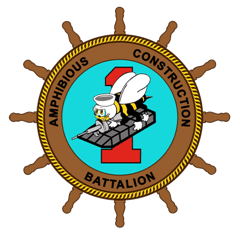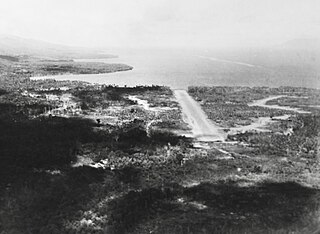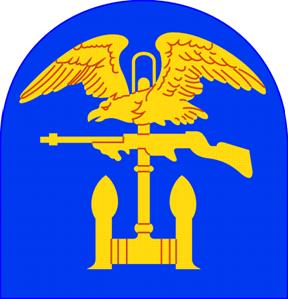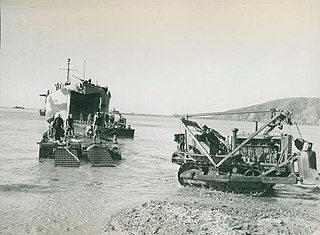
The Battle of Milne Bay, also known as Operation RE or the Battle of Rabi (ラビの戦い) by the Japanese, was a battle of the Pacific campaign of World War II. Japanese marines, known as Kaigun Tokubetsu Rikusentai, with two small tanks attacked the Allied airfields at Milne Bay that had been established on the eastern tip of New Guinea. Due to poor intelligence work, the Japanese miscalculated the size of the predominantly Australian garrison and, believing that the airfields were defended by only two or three companies, initially landed a force roughly equivalent in size to one battalion on 25 August 1942. The Allies, forewarned by intelligence from Ultra, had heavily reinforced the garrison.

HMAS Manoora was an ocean liner that served in the Royal Australian Navy (RAN) during World War II. She was built in Scotland in 1935 for the Cairns to Fremantle coastal passenger run for the Adelaide Steamship Company. She was requisitioned by the RAN for naval service in 1939. Manoora was initially converted into an armed merchant cruiser (AMC), operating primarily in Australian, New Guinea, and Pacific waters, with deployments to Singapore and the Bay of Bengal.

Operation Chronicle was the Allied invasion of Woodlark and Kiriwina Islands, in the South West Pacific, during World War II. The operation was a subordinate action that formed part of the wider Operation Cartwheel, the advance towards Rabaul. An early planning name for this operation was Operation Coronet. Preliminary actions commenced on 23–24 June 1943 when small reconnaissance parties were landed on both islands. The main operation was executed without opposition on 30 June 1943. Around 16,800 personnel took part, divided into two forces. The United States Army provided the majority of ground troops, which were supported by a United States Marine Corps defense battalion as well as U.S. and Australian aircraft and naval vessels.

Amphibious Construction Battalion ONE is an amphibious construction battalion in the United States Navy based in Coronado, California, and last in type unit. Amphibious Construction Battalion TWO was its sister unit based in Little Creek, Virginia.

HMAS Gladstone (J324/M324), named for the city of Gladstone, Queensland, was one of 60 Bathurst-class corvettes constructed during World War II, and one of 36 that were initially manned and commissioned solely by the Royal Australian Navy (RAN). Built by Walkers Limited, the ship was commissioned in 1943.

HMAS Assault is a former Royal Australian Navy (RAN) training centre that was in use during World War II, located at Nelson Bay in the Mid North Coast region of New South Wales, Australia.

Turnbull Field was an aerodrome near Gili Gili, Papua New Guinea.

Samarai Advanced Seaplane Base was a US Navy seaplane base at Samarai Island, Papua New Guinea during World War II.

The Engineer Special Brigades were brigade-sized amphibious forces of the United States Army developed during World War II and active from 1942 to 1955. Initially designated engineer amphibian brigades, they were redesignated engineer special brigades in 1943. The 1st, 5th, and 6th Engineer Special Brigades were assigned to the European Theater of Operations. The 1st Engineer Special Brigade participated in the landings in Sicily and Italy before joining the 5th and 6th Engineer Special Brigades for the invasion of Normandy.

Amphibious Construction Battalion TWO was an amphibious construction battalion in the United States Navy based in Little Creek, Virginia. ACB 2 was decommissioned on 31 March 2023.

Gili Gili is a village in Milne Bay Province, Papua New Guinea. The village is located between Swinger Bay-Alotau to the east and Ladava to the west in Milne Bay north shore.

HMAS Ladava is a former Royal Australian Navy (RAN) base that was located at Milne Bay in Papua New Guinea.

Construction Battalion Maintenance Unit THREE ZERO TWO (CBMU-302) of the U.S. Navy was commissioned on 31 March 1967. Along with a sister unit, CBMU-301, was also commissioned. They were the first CBMUs commissioned since the two that came and went with the Korean War. The official commissioning ceremony of CBMU-301 and CBMU-302 was held at the U.S. Naval Construction Battalion Center, Port Hueneme, CA on 7 April 1967. LT Mel Harper was the first Commanding Officer.

Naval Mobile Construction Battalion TWO SIX was a United States Navy Seabee battalion commissioned in 1942 for support to Naval Operations in the Pacific Theater in World War II and later a Reserve Naval Construction Battalion based in various locations in the Midwest from 1962 until 2014.

US Naval Advance Bases were built globally by the United States Navy during World War II to support and project U.S. naval operations worldwide. A few were built on Allied soil, but most were captured enemy facilities or completely new. Advance bases provided the fleet with support to keep ships tactically available with repair and supply depots of facilities, rather than return them to the continental United States. Before Japan declared war on the United States the U.S. Navy had a single fleet-sized advanced base in the Territory of Hawaii at Naval Station Pearl Harbor. During the war the U.S. Navy Seabees built over 400 advance bases categorized by size. Naval bases were either Lions or Cubs while airfields were either Oaks or Acorns. Lions and Oaks were major facilities while Cubs and Acorns were minor. PT Boats typically would get a Cub and airfields with single runways were Acorns. The larger bases could provide refueling and overhaul; loading of troopship and cargo ships; and preparing amphibious assault ships. Some became major repair depots. The Seabees developed auxiliary floating drydocks were able to repair battle damage and do regular maintenance in the field saving ships trans-pacific trips for repair. A few bases also were developed to be R and R for all U.S. personnel. Most Advance Bases were built by the US Navy's Seabees in Naval Construction Battalions (CBs). At the start of the war civilian contractors were employed in construction. The Seabees in World War II built most of the airfields used by the United States Army Air Forces and United States Marine Corps, as they had the ships and cranes needed to transport the vast amount of equipment needed at the advance bases. The US Army and United States Coast Guard also operated out of many of these facilities. Seabees could build new or repair damaged runways, and with advancements in heavy bomber technology lengthen runways as needed. A few Naval Advance Bases were built for the Korean War and Vietnam War.

Naval Base Milne Bay, also called Naval Advance Base Milne Bay, was new major United States Navy sea and airbase base built on Milne Bay in Milne Bay Province in south-eastern Papua New Guinea. By spring 1943, the build up of the US Navy to support the Pacific War had caused overcrowding at the ports on the east coast of Australia. To help, Seabees departed Naval Base Brisbane on June 19, 1943 to set up a new base in Milne Bay. Naval Base Milne Bay headquarters was at Ladava Navy Base. The Royal Australian Navy already had a small base in Milne Bay: HMAS Ladava. Australians were able to defend and keep Milne Bay in the Battle of Milne Bay in 1942. Naval Base Milne Bay was built during World War II to support the many ships and aircraft fighting and patrolling in the South West Pacific theatre of war. Ladava Navy Base provided a large protective US Navy fleet anchorage at Gahora Bay next to Ladava. At Naval Base Milne Bay, Seabees built a large Naval facility.

Naval Base Brisbane was a major United States Navy base built in the early part of World War II at Brisbane, Queensland, Australia. At first, operated as a base for patrol aircraft and convoy escort aircraft to protect the last leg of the Pacific War to the Southwest Pacific. As the US Navy expanded in the island hopping campaign, Naval Base Brisbane expanded to include a submarine base, repair depot, seaplane base and other facilities. US Navy operations started on April 14, 1942, and ended after the war in 1945.
Naval Base Sydney was a United States Navy base built during World War II at Sydney, New South Wales, Australia. The base was built with Australian civilian contractors. As the US Navy expanded in the Island hopping campaign, Naval Base Sydney expanded to include a Naval Base Hospital, repair base and other facilities. US Navy operations started in 1943 and ended after the war in 1945.

Naval Base Alexishafen was a United States Navy base built during World War II at Alexishafen, north of the city of Madang in New Guinea. The base was built by the US Navy Seabees starting June 13, 1944 as part of the New Guinea campaign of the Pacific War. The base was built at the request of the Seventh Amphibious Force of the United States Seventh Fleet to support the many boats patrolling the area. The US Navy built a boat repair depot including Auxiliary floating drydocks. The base was closed in January 28, 1945.

Amphibious Training Base (ATB)(USNATB) Advance Amphibious Training Base are United States Armed Forces bases used for the training of amphibious warfare. Starting with World War II, United States Navy began large-scale amphibious assaults of beaches. To train troops in the use of Amphibious warfare ships and Amphibious Combat Vehicles the Navy established training bases both on the US mainland and overseas at US Naval Advance Bases. The Training involved the United States Navy working with The United States Marine Corps, United States Army and in later years sometimes the United States Air Force for air support.

















